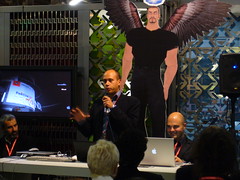We all have, sooner or later depenging on how you feel lucky, a frightening story about helpdesks: labyrintic menus, looping hold-on messages, and ultra-dumb helpdesk guys (ever felt that strange experience when every guy you talk to asks the same identical question before passing your call to the next one?).
Believe me, I’ve always been kinda unlucky with helpdesks. Unfortunately. So I was happy my first day at Gabetti to discover I would have worked shoulder to shoulder with a small helpdesk team serving our 1000 agencies on IT related problems.
Back in June 2006 the only way to contact the helpdesk was to give a call to a phone number behind which laied an exchange that took care of the call forwarding to the first free operator. In other words the process was something like
- call the number
- stay at least 15 mins (if you’re the lucky boy) on hold
- explain your problem to the operator (other 15 mins, at least)
- wait until the IT team solves your problem
A syncronous helpdesk is a waste of time for everybody: for who has the problem and for those who solve it.
Then we started innovating the technology and the processes below the IT helpdesk; our keyword was “asyncronous”.
The first step was to provide the support team and our users with a web interface, with proper problems sections, to communicate and manage tickets. We’re really really happy with the open source software OTRS which could be managed both via email and web and is plenty with personalizations.
That was an important shift from syncronous to asyncronous assistace which brought some interesting features to our helpdesk structure:
- Our clients wouldn’t have to wait for a free operator to communicate their problems anymore
- We have the power to simultaneously close a large number of tickets in the very moment (that is to say make more users happy in less time)
- We can prioritize problems (both basing on the quantity and quality data of our users’ problems)
With just this change we obtained a huge (nearly half an hour) speed up of the ticket opening. Not bad, huh?
But the we moved fast forward both from the technology and process points of view: we rolled out Gabi, our Virtual Assistant, back in July to manage the whole help desk front-line and, more recently, we choosed to prioritize our asyncronous tools (such has gabi itself and the online helpdesk) by cutting the telephone helpdesk times from 8 to 3 hours a day.
Even if this strong move towards the asyncronous life style hasn’t already showed its entire potential the results are huge: the mean life time of each ticket is now something less than 1.5 days and the monthly helpdesk performance has gained full 44 man hours (which is something more than the Italian equivalent of the work week).

 I’m on a fast train connecting Florence to Milan together with my colleague Luciana (aka the uber wonderful
I’m on a fast train connecting Florence to Milan together with my colleague Luciana (aka the uber wonderful